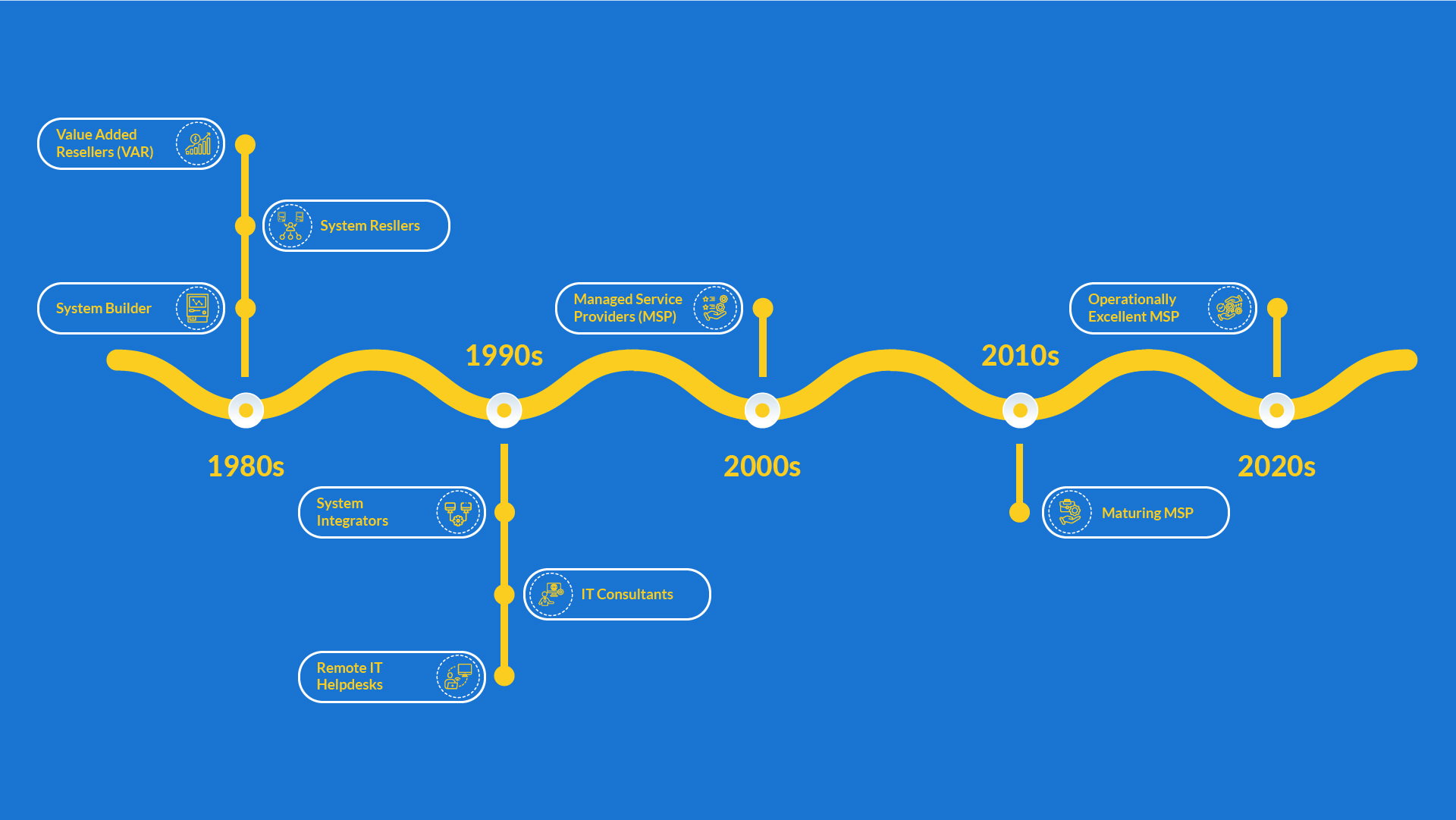MSP is an acronym for Managed Services Provider. But what does that mean in the world of IT?
An MSP relieves businesses of the burden of managing their IT infrastructure and processes. The infrastructure managed ranges from user devices and computers to firewalls, routers, switches, active directories, email, and other servers. This is done from a centralized software or technology stack to monitor and troubleshoot remotely.
In short, an MSP serves as the IT department for many companies. You might hear of an MSP, a managed IT firm/vendor, or an IT management company.
What size business and type of industry is best served by an MSP?
The MSP model of IT management is ideally suited for small-to-midsize businesses – those with as few as two users and up to 500. Organizations with more than 500 staff operate best with a robust in-house department with enough computer engineers to cover any contingency, including systems administrators, troubleshooting engineers, project managers, and a chief information officer, among other roles.
Partnering with an MSP means these in-house roles are covered without the expense of hiring, and some (including Endsight) offer a Technical Account Manager. While the MSP is responsible for IT, oversight from the C-suite is essential. An MSP worth your time and money should provide proven results that optimize operational efficiency and boost the bottom line.
Industries that an MSP best serves include law firms, financial firms, engineering, architecture, nonprofits, manufacturers, wineries, and city governments. And while most high-tech companies have a solid functional IT core, they sometimes work with MSPs.

The history of the managed services business model
Of course, the fundamental principle of filling a need applies here. And this need emerged far before the technology that made it possible to log onto computers remotely. The history of the MSP can be found in the computer industry as a whole, beginning with system builders and resellers.
The history of information technology goes back hundreds of years to when information was stored systematically. However, the MSP model was shaped by pivotal events beginning in the 1980s and continues to evolve.
First, they were the system builders…
In the early 1980s, the personal computer industry was just starting, and IT services firms called themselves "system builders." Many small regional firms sold what used to be known as 'white box' computers.
Over time, large companies like IBM, Compaq, HP, Gateway, and Dell began building these computers for much cheaper because they had much better economies of scale than the smaller system builders. This drove down the price point of personal computers.
Who then became the system resellers to increase margins
Many of the smaller firms found that their profit margins were better when they resold what, the larger HP and Dell computer companies were producing, moving away from building computers because labor was too expensive. The "systems reseller" era was born, and business was good. This was before the direct-to-consumer phenomenon that the internet made possible. The larger companies needed these smaller companies to get their computers out to the regional market. CRN (Computer Reseller News) Magazine still stems from this era.
Who became value-added resellers who performed more complex tasks
Local IT firms needed a way to differentiate themselves, so they started "adding value" to maintain healthy margins. They offered computer installations and troubleshooting as a value add in the first few months to a year.
These were called VARs or value-added resellers. They would help your business get all set up and figure out more complex things, like making one computer talk to another. You will hear that term used a lot in the IT management industry.
In the 1980s, they became systems integrators to improve infrastructures
In 1989, Tim Berners-Lee established his proposal for the World Wide Web, making the Internet, created seven years earlier, much more accessible and valuable to small businesses. By the mid-‘90s, technology had become complex, and capabilities to network computers were now possible.
Companies found a competitive edge by making multiple computers talk to each other. By this time, almost all small businesses had an internet connection and needed appropriate devices, like switches, routers, and firewalls, to make the entire IT infrastructure work together. The VARs started calling themselves "systems integrators."
These businesses assumed a consulting role for best practices
By the late ‘90s, IT services became the dominant source of profit and differentiation in the IT industry. One system integrator would have a way of doing things that didn't work for a particular business. A small business might ask a systems integrator for a second opinion on their setup.
This was the fundamental shift when system integrators started stepping into advising on best practices for making technology work for businesses. Pretty soon, systems integrators abandoned the term and called themselves IT consultants.
The start of the MSP
At the same time, in the late ‘90s, internet speed reached the point where computer applications could be deployed from a central place. This was the start of the dot com era, and companies were developing software that enabled IT professionals to connect to a computer and do things like remote computer control and management.
This allowed IT professionals to troubleshoot over the Internet from an IT help desk. Some platforms made automation possible through scripts and customized coding. Several web apps could come together and solve problems in a streamlined way. IT consultants who used this central connectivity could deploy those solutions to other customers.
The early 2000s was the start of the managed IT services industry. Many IT consultancies adopted the term “managed services provider.” They filled their firm with computer engineers with the variety of skill sets needed to provide a more robust IT infrastructure than any single IT consultant could not do on their own.
Endsight was founded right around this time in 2004. Today’s MSPs do almost everything – from building and reselling systems to helping with IT strategy to managing networks and IT infrastructure remotely.
Managed service providers today
A lot has shifted in recent years. Third parties that provide applications that help MSPs have come and gone. Best practices have emerged, and by the 2020s, the managed IT services industry had become a mature market and the predominant business model of choice in the IT services space.
On the surface, every MSP looks almost like the next, but critical differences exist between one IT management company and another.
Many MSPs are started by a single IT professional working for a small or medium-sized company who decided to parlay their experience into starting their own business. However, while they may provide technical resources, they know next to nothing about business and its financial intricacies, human resources, and lack leadership skills, etc. – all essential components to scale a business.
It's worth noting that some MSPs are owned by private equity companies, and on the surface, they may seem like well-capitalized and professional operations. However, in some cases, there may be issues with integration and customer service. Some private equity-owned MSPs may be composed of poorly integrated small companies, and customer service may take a backseat to the pursuit of profit.
The MSP customer can be their own worst enemy.
Profit is important, but many MSP customers seek to lower their spending to the extreme. The adage “penny wise, but pound foolish” comes to mind as some MSP customers tend to sacrifice quality and effectiveness to lower their IT spending.
In the past, this resulted in the refusal to upgrade equipment, even when recommended. Customers were willing to throw best practices out of the window if it meant allocating more budget to IT. The combination of the refusal by clients to pay what was necessary and IT service providers who wanted to stay in business led to substandard infrastructure.
A tight labor market brings challenges for MSPs
The demand for talented IT workers has soared as the number of available experts has decreased. There’s a talent war, and private equity companies and small IT firms with young business models can’t compete for the cream of the crop - they just lack the business maturity that the best candidates look for.
For example, take one critical facet of business regarding the MSP business model: scalability. Many MSPs find it very hard to take on new clients, especially when that client is in the 200+ employee range. Why? It's because they are most suited to only working with small networks. Just the volume of support inquiries alone from 200+ clients is enough to make every other client suffer when the MSP is only a handful of people.
The Future of the MSP
The need for MSPs will continue to grow at a rate of about 12% annually. This opens the floodgates for immature MSPs who can barely preserve the status quo, much less help a business scale. A mature managed service provider is your essential IT resource, providing all IT services in one complete package.
The future of IT managed services lies in proactive IT surveillance, data security, and cloud solutions as virtually everything converts to an as-a-service model. Your business success depends on selecting the right MSP to meet tomorrow’s tech – AI, IoT, Blockchain, enhanced security – with forethought and expertise.
It's important to vet the MSP when choosing which to work with, and there are some top questions you can ask when selecting an IT vendor – we've included them in our report: How to select an IT vendor.
Looking for the proper MSP can be challenging. Find out why and how to navigate the selection by downloading the Insider’s Take on the MSP Industry.





/jclause.jpg)

